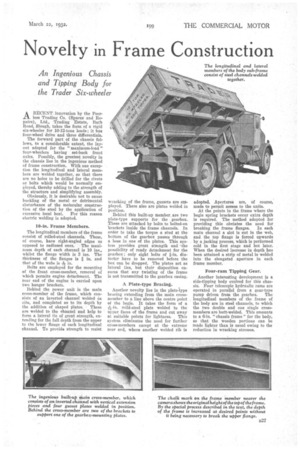Novelty in Frame Construction A RECENT innovation by the Peer
Page 45

If you've noticed an error in this article please click here to report it so we can fix it.
less Trading Co. (Spares and Repairs), Ltd., Trading Estate, Bath Road, Slough, takes the form of a rigid six-wheeler for 1042-tons loads ; it has four-wheel drive and three differentials.
The forward part of the chassis follows, to a considerable extent, the layout adopted for the "maximum-load " four-wheelers having set-back front axles. Possibly, the greatest novelty in the chassis lies in the ingenious method of frame construction. With one exception the longitudinal and lateral members are welded together, so that there are PO holes to be drilled for the rivets or bolts which would be normally employed, thereby adding to the strength of the structure and simplifying assembly.
Obviously, it is desirable not to cause buckling of the metal or detrimental disturbance of the molecular construetion of the steel by the application of excessive local heat. For this reason electric welding is adopted.
10-in. Frame Members.
The longitudinal members of the frame consist of rolled-steel channels. These, of course, have right-angled edges as
opposed to ratliused ones. The maximum depth of each channel is 10 ins., whilst the flange width is 3 ins. The thickness of the flanges is in. and that of the webs is A in.
Bolts are employed for the mounting of the front cross-member, removal of which permits engine detachment. The rear end of the engine is carried upon two hanger brackets.
Behind the power unit is the main cross-member of the frame, which consists of an inverted channel welded in situ, and completed as to its depth by the addition of shaped Plates. These are welded to the channel and help to form a lateral tie of great strength, extending for the full depth from the upper to the lower flange of each longitudinal channel. To provide strength to resist wracking of the frame, gussets are employed. There also are plates welded in. position.
Behind this built-up member are two plate-type supports for the gearbox. These are attached by bolts to bolted-on brackets inside the frame channels. In order to take the torque a stud at the bottom of the gearbox passes through a boss in one of the plates. This system provides great strength and the possibility of ready detachment for the gearbox ; only eight bolts of g-in. diameter have to be removed before the box can be dropped. The plates act as lateral ties, but their disposition ensures that any twisting of the frame is not transmitted to the gearbox casing.
A Plate-type Bracing.
Another novelty lies in the plate-type bracing extending from the main crossmember to a line above the centre point of the bogie. It takes the form of a mild-steel plate welded to the upper faces of the frame and cut away at suitable points for lightness. This system eliminates the need for further cross-members except at the extreme rear end, where another welded rib is adopted. Apertures are, of course, made to permit access to the units.
At the points in the frame where the bogie spring brackets occur extra depth is required. The method adopted for providing this obviates the need for breaking the frame flanges. In each main channel a slot is cut in the web, and the top flange is forced upwards by a jacking process, which is performed cold in the first stage and hot later. When the desired increase in depth has been attained a strip of metal is welded into the elongated aperture in each frame member.
Four-ram Tipping Gear.
• Another interesting development is a side-tipping body evolved for this chassis. Four telescopic hydraulic rams are operated in parallel from a gear-type pump driven from the gearbox. The longitudinal members of the frame of the body are in steel channels, to which the two double and one single crossmembers are butt-welded. This amounts to a 6-in. "chassis frame" for the body, so that the wooden portions can be made lighter than is usual owing to the reduction in wracking stresses.




































































































